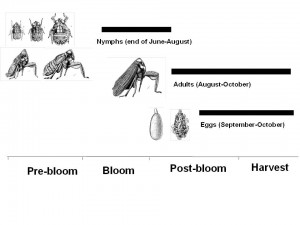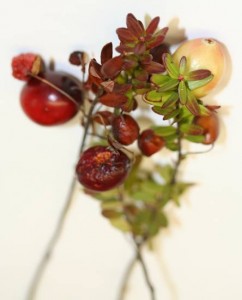Last year we observed damage in cranberry bogs by the cranberry toad bug, Phylloscelis atra, in New Jersey. Although we had seen toad bugs in cranberry bogs in the past we had never seen them causing damage to the vines and fruit. Toad bugs are hemipteran insects, similar to blunt-nosed leafhoppers, but belong to the Family Fulgoridae (planthoppers) as opposed to leafhoppers, which belong to the family Cicadellidae.
Life Cycle
Toad bugs feed only on cranberries. This insect has a single generation per year. It overwinters as eggs. The nymphs appear by the end of June through August, and the adults from August through October. Eggs are laid from September through October.
Damage
Feeding damage can be noticed in two stages. First stage feeding damage on vines causes closing in (towards the branch) of the leaves on the new growth. Second stage feeding causes changed in color (reddish to brown) of new growth. The damage can be seen from July until harvest. This damage will cause dying of the branch and the berries to shrivel up. Heavy infestation will result in dwarfed berries.Management
To determine infestation, lightly sweep problematic beds (bugs should be easy to catch in sweep nets as they are very active). Because this is a new pest there is no threshold established yet. Thus, insecticide applications should be based on the relative number of bugs per sweep compared with other sites and previous history of infestation. Currently, growers can use two control options: Imidan 70W (broad-spectrum organophosphate) or Assail 30SG (neonicotinoid insecticide, effective against piercing-sucking insects). If infestation is high, treatments should be applied at this time of the year.
For more information, please see “The Cranberry Toad-Bug” by F.A. Sirrine and B.B. Fulton. 1914. New York Agricultural Experiment Station. Bulletin No. 377. Department of Agriculture, Geneva, NY.



